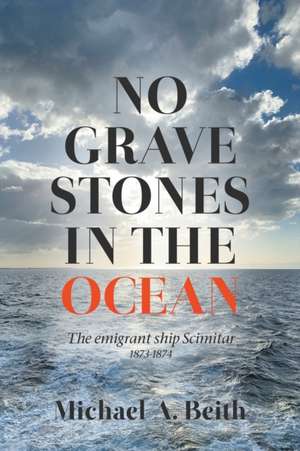No Gravestones in the Ocean
Autor Michael A. Beithen Limba Engleză Paperback – 8 aug 2019
The arrival of Scimitar flying the yellow flag, the international signal warning of disease on board, confirmed what they already feared - that yet another ship would be quarantined and her passengers and cargo detained at extra cost and with the risk of importing contagious disease to the young colony. There was also a reputational cost to be considered as New Zealand had embarked on an ambitious programme of expansion to its infrastructure which needed a large influx of immigrants and already incurring enormous loans to finance it. It had experienced difficulty in attracting immigrants in sufficient numbers and had just started to encourage agricultural and rural trade unions to assist in recruitment of suitable candidates.
Responsibility for emigrant selection and transportation lay with New Zealand's first diplomat, Dr Isaac Earl Featherston resident in London. Since 1871, when he began his quest for emigrants, he had received frequent criticism of his management style and now he was firmly in the firing line to take the blame. His prime adversary in New Zealand was no less a person than the Premier himself, Julius Vogel CMG, architect of the expensive colony development plan.
This book examines the Scimitar story from before she set sail, including the daily account written by her captain, James Fox, full details of the Royal Commission of Inquiry and of the evidence submitted to it. The repercussions of the Inquiry's conclusions resulted in a stream of letters and reports between New Zealand officials, UK institutions and others accused of hindering the safe passage of emigrants. The Commission's report revolved around the evidence of Scimitar's surgeon-superintendent, Dr. William H. Hosking, who contested the manner in which his evidence was used and recorded. The book reveals how the poor working relationship between Julius Vogel and Dr. Featherston delayed improvements to the emigration process.
| Toate formatele și edițiile | Preț | Express |
|---|---|---|
| Paperback (1) | 118.95 lei 6-8 săpt. | |
| New Generation Publishing – 8 aug 2019 | 118.95 lei 6-8 săpt. | |
| Hardback (1) | 174.24 lei 6-8 săpt. | |
| New Generation Publishing – 9 aug 2019 | 174.24 lei 6-8 săpt. |
Preț: 118.95 lei
Nou
Puncte Express: 178
Preț estimativ în valută:
22.76€ • 23.72$ • 18.85£
22.76€ • 23.72$ • 18.85£
Carte tipărită la comandă
Livrare economică 03-17 aprilie
Preluare comenzi: 021 569.72.76
Specificații
ISBN-13: 9781789556308
ISBN-10: 1789556309
Pagini: 330
Dimensiuni: 152 x 229 x 18 mm
Greutate: 0.44 kg
Editura: New Generation Publishing
ISBN-10: 1789556309
Pagini: 330
Dimensiuni: 152 x 229 x 18 mm
Greutate: 0.44 kg
Editura: New Generation Publishing
Notă biografică
The author has forebears that include four deep-sea master mariners who cut their teeth in sail in the 19th century so it is unsurprising that he has a primary interest in full-rig sailing ships loosely referred to as 'windjammers'. The last master mariner in the family became Commodore of Elder Dempster in 1930 after a long career which began as an apprentice on Maraval, a full-rig sailing ship commanded by his Uncle in the 1880's. The authors focus is in the period when sail eventually gave way to steam in the latter part of the Victorian period and is often referred to as the heyday of sail. His specific interest is in the sailing ships engaged in the emigrant trade to New Zealand. After an in-depth study of one emigrant ships voyage to Otago in 1873 he decided to put his research together in this, his first book which reveals the experiences of emigration to the furthest distant colony. Emigrants who already knew the circumstances of hardship and longing for a better future had first to endure the long sea voyage which often brought its own trials. His own career began in the study of maritime communications at a time when long distance communication at sea was still carried out using HF radio and Morse code before satellite technology was developed and became the norm for both communication and navigation. He later became a medical electronics engineer specialising in implantable devices. He is retired and lives in Ayrshire, Scotland.
